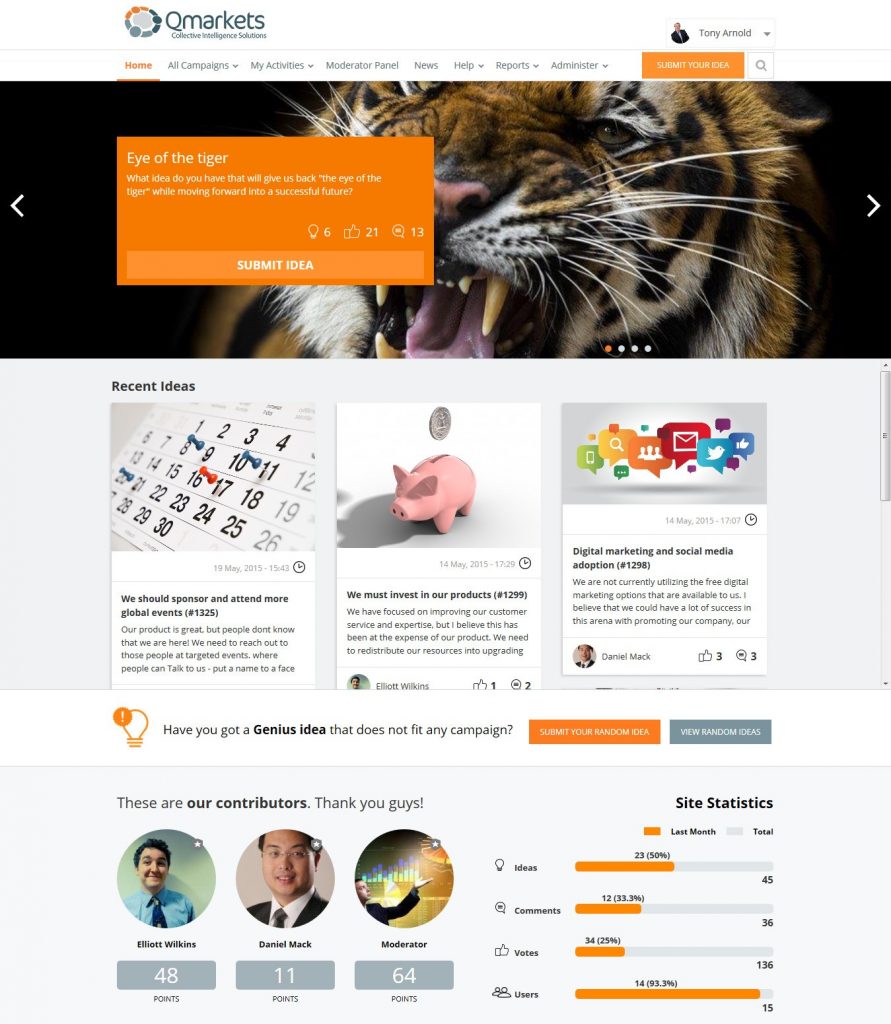The problem with democracy is that we can’t all always be in charge; one way or another there has to be someone at the top who holds the power to make that crucial final decision. As drastic as this comparison might seem, the very same quandary exists within the field of innovation management: How do you combine the invaluable collective intelligence of a large audience, with the irreplaceable analysis of a small group of experts?
In the world of politics, this issue is an obstacle which has proven incredibly hard to overcome, however in the world of business we are beginning to see a solution. The application of a system which eliminates this juxtaposition is effectively priceless, resulting in an ideas tool with countless uses, from solving problems and forecasting success, to making tough business decisions and generating new product ideas. Read on to discover how to improve innovation in the workplace with this methodology and technology.
 Evaluating Evaluation
Evaluating Evaluation
Evaluation is an important and yet all too frequently overlooked aspect of the innovation management process. When the best ideas have been combined, fine-tuned, and polished, it’s time to subject them to evaluation. This helps ensure that any ideas that have a promising veneer, but are poorly thought out, will be identified before resources, funding and time have been poured into them.
Generally speaking there are two types of evaluations: Crowd Community Voting and Expert Reviews. In contrast to a vote, which can be cast by any user in the idea community, expert reviews can only be performed by people who are assigned as innovation experts to a campaign or to a specific idea.
 Crowds vs. Single Experts
Crowds vs. Single Experts
“Quality Over Quantity” is a commonly used motto. However Collective Intelligence actually works according to the opposite principle. Studies show that when it comes to evaluating how to improve innovation in the workplace, quantity is generally more accurate than quality. Statistically, if you ask 1000 people about anything, their aggregate answer is more likely to be correct than the one of a single expert on the subject. This concept, also known as crowdsourcing, is used to great effect by innovation software.
 The Weight of Numbers
The Weight of Numbers
Each one of us has personal preferences and predispositions. But ideas voted on by a crowd have a high chance of being objective. If there are one or two people in the group with strong opinions or biases, these will be statistically outweighed by the majority. In contrast, expert evaluations rely on only a handful of people providing feedback. If one or two have a bias or make a mistake, the results can be drastically skewered. Then ideas which could be very valuable may be ignored or rejected. Its therefore important to not only select the right experts for the evaluation, but also to use an ideas tool which fully optimizes this process, giving accountability to each expert, and minimalizing the possibility of error.
 Single Experts vs Crowds
Single Experts vs Crowds
This does not mean that quality expert opinions are useless. Single experts are often prized because they have department-specific knowledge. For example; financial experts know company budgetary info and can give full financial forecasts/breakdowns, technology experts know if a solution is technically possible, and lawyers can tell if the solution is legally viable.
 Utilizing Experts and Crowds with idea tools
Utilizing Experts and Crowds with idea tools
It is now becoming common practice for companies to use collective intelligence to make business decisions and generate innovative ideas. This is achieved through the use of innovation management software, however the vast majority of vendors in this market sell off-the-shelf products which are almost identical to basic social media platforms. At Qmarkets we realize how crucial it is to employ a solution which is tailored to your requirements, which is why we have developed a full suite of collective intelligence tools, each of which allow you to harness the power of not just your crowds, but also your experts.
 Assigning Experts
Assigning Experts
One or more experts are assigned to each idea, along with separate instructions and due-dates for each. This can be done either manually or automatically. Manual assignment can be completed by campaign managers or moderators, by simply searching for the designated expert with a selection widget. Automatic assignment of experts can be performed by one of several rules defined during setup: according to the manager/expert of the submitter’s department, category of the idea or expert best suited to the idea’s content.
All experts should answer the same questions so their opinions can be compared and quantified. A systemized score-card should be provided to each expert with gradable scores for each criteria as well as room for comments. The campaign manager or moderator generally defines the criteria for the expert idea evaluation.
 Carrying Out the
Carrying Out the Evaluation
Evaluation
Expert reviewers receive special tracking pages to be able to see ideas that are waiting for review/evaluation, ideas evaluated, etc. The experts are invited to rate ideas based on the pre-defined criteria as well as provide a detailed analysis of them. Each criterion, as well as the final evaluation result, comes with an info button that offers additional information, and a comment button, where evaluators can leave a comment.
 Managing the Expert Evaluations
Managing the Expert Evaluations
To ensure proper completion, the expert evaluations need to be monitored and managed by the innovation process moderators. The moderators can:
✔ Track the status of any idea, including – how many experts reviewed it, who is still pending, etc.
✔ Interact with the experts regarding their review – ask for clarifications, reject/delete a review, etc.
✔ Select a review as the leading/chosen one – which will then be highlighted and become part of the idea, as it progresses through the pipeline.
Once all (or X) experts are finished, the moderator is notified and the idea is automatically moved to a new stage.
 Collective Expertise
Collective Expertise
So ultimately solution is a simple one – turn your select group of experts into a large group of experts, and gather their collective expertise. With many platforms this is impossible, as the evaluation tools and functions are incredibly limited. However with Qmarkets’ idea management system this process is made easy with idea creation tools such as score cards, token voting, and idea tournaments, which allow large audiences to provide detailed feedback with relation to a variety of different criteria. While this principle will not always be possible to implement, it can fuel the most powerful business tool in the world when applied correctly.
To discover how to improve innovation in the workplace with Qmarkets, don’t hesitate to contact us today.


 Assigning Experts
Assigning Experts
 Evaluation
Evaluation